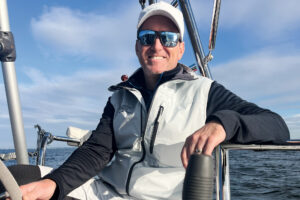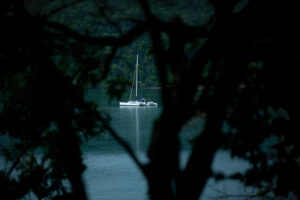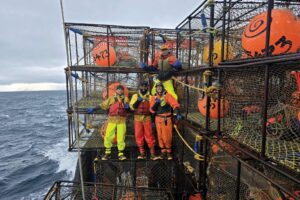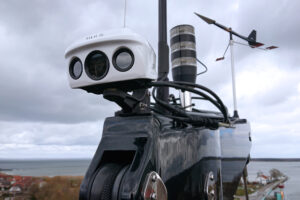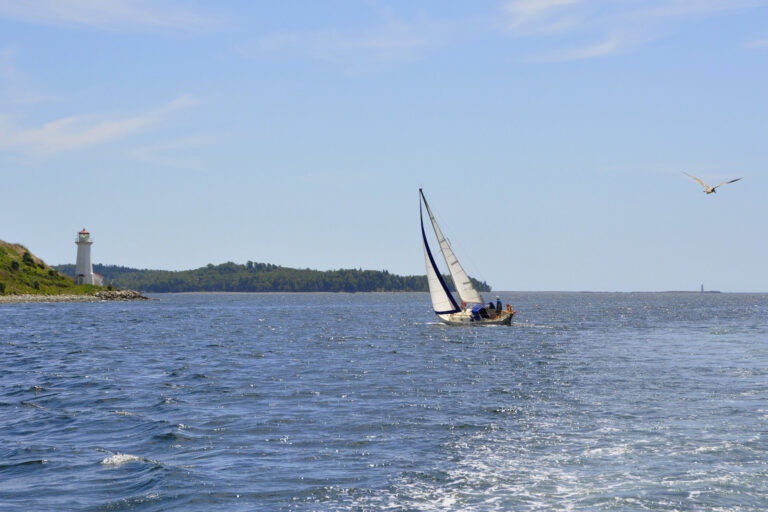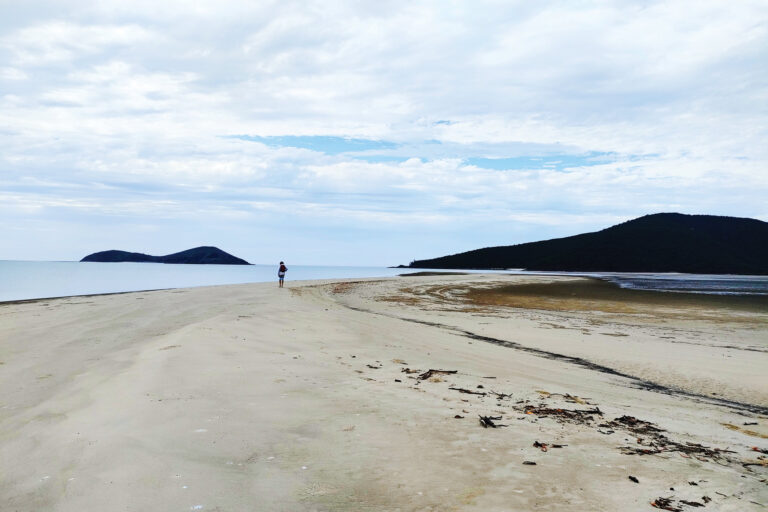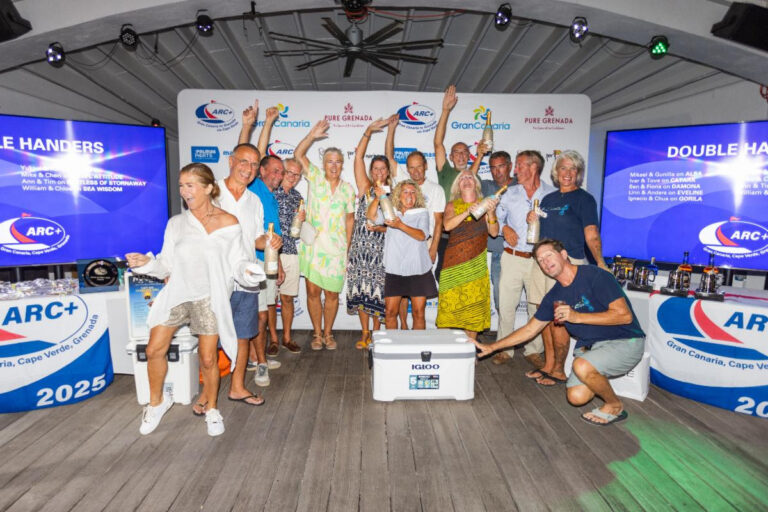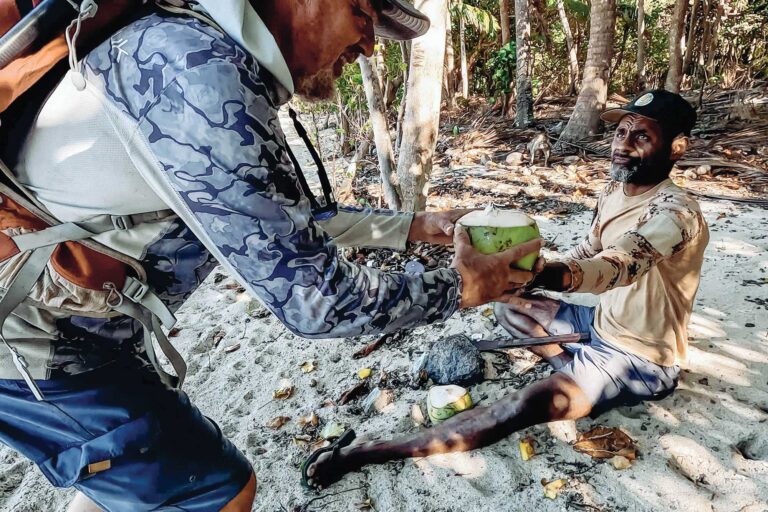
Oyster 72
I’d sailed with owners Cristina Rapisardi and Giovanni Cristofori on their Oyster 72, Billy Budd, to the unfrequented shores of Baffin Island in search of wildlife and mountains, but now we needed fuel-lots of it-and there was nowhere we could go alongside for hundreds of miles.
Eventually finding that diesel could be purchased in 50-gallon drums in the town of Pond Inlet, we came up with a suitable, if somewhat unorthodox, plan. After carefully checking for leaks, we towed the drums with the dinghy, one by one, out to the anchored yacht. Hoisting the barrels aboard with a halyard, we filled the tanks using a small submersible pump, a quicker method than using a siphon, and much less likely to lead to a mouthful of diesel. It took 45 minutes to load 400 gallons of fuel.
My company, High Latitudes (www.highlatitudes.com), had been hired to oversee the building of Billy Budd and had planned the modifications needed to make sure it was prepared for high-latitude cruising. After it was launched we took on the job of managing the boat, and I stayed on as skipper for the first year. The owners were on board for cruises in the Canary and Cape Verde Islands, Cuba, and the Caribbean, before heading north to Greenland for this Arctic expedition in August 2006.
Early in the day we’d dropped anchor in Pond Inlet, at the northern end of Baffin Island, and roused the local policeman from his bed to clear the boat in to Canada from the west coast of Greenland. It was a first for him and involved lengthy phone calls to the customs and immigration services. He was friendly and helpful, and all went smoothly. We entertained him on board that evening for his trouble.
After a month wrestling with the language barriers of Greenland, a Danish protectorate and inhabited by the Inuit, we thoroughly enjoyed being able to converse freely with the Inuit in Canada, most of whom speak English fluently. Often family parties of hunters who happened to be passing by visited us in anchorages. While naturally quite shy and reserved, they wondered what we were up to and were happy to give any advice or assistance we needed.
Inuit hunting activities are strictly controlled-essential when a single polar-bear skin sells for around $1,500. The hunters explained that each man has a limit of only one bear a year. The system seems to work, as we saw nearly 30 polar bears during our time on the Canadian side of Baffin Bay. Often they were close to settlements, where they’re not disturbed unless they become threatening.
We spent two days exploring the fjords southwest of Pond Inlet where we’d heard that narwhals were often seen. Sure enough, we were rewarded with our first sight of these majestic animals. Allegedly the source of the legend of the unicorn, they have a long tusk protruding from the front of their heads. If you’re lucky, you’ll see the males “jousting” as they fight with these tusks.
The Inuit hunt the narwhal-again under a system of limits-as do polar bears, walruses, sharks, and orcas. The thick blubber just under the skin, mutuk, is favored for food, and the impressive tusks, which are an eruption of one of the front two teeth, and generally only found on males, are either sold whole or carved into intricate sculptures.
One night we anchored in Albert Harbour east of Pond Inlet. We presumed that anything with “Harbour” in its name should provide a safe refuge, but it proved typical of the anchorages we would find in the fjords around the island; very deep and steep-to. We anchored in 80 feet of water and took a long line ashore. Usually we looked for rivers, which are likely to produce deposits where a good, relatively shallow anchorage might be obtained. We found that topographical maps were the best way to find them.
We had little sleep that night as the wind picked up on the beam. Thankfully, the anchor held and we left at 0630 to explore the fjords to the south, heading straight for the Buchan Gulf, some 100 miles away. The coast was getting steeper, which we hoped would provide some good rock climbing. Unfortunately, low, wet clouds obscured all but the lower 300 feet or so of the cliffs, making the prospect of climbing less than tempting.
It was there that we saw, foraging on the rocks at the base of the cliffs, our first of many polar bears. These creatures look beautiful and powerful, and it’s sometimes hard to realize how dangerous they are. On our trips ashore we always carried a rifle, as they’re one of the few mammals that consider humans food. We also carried a flare pistol with flash-bang type cartridges; the theory being that if the bear is 150 feet or more away, you would fire the flare pistol to scare it off. Fortunately, we never had to use either, but once we did have to beat a hasty retreat to the boat after spotting a bear coming in our direction.
Exploring the northernmost arm of the fjord, we eventually found soundings and a deep anchorage off a river in the northwest corner. The weather was atrocious, with katabatic gusts coming at us from above. The next few days were spent exploring Buchan Gulf and Paterson Inlet with climbing activity limited by the bad weather. But we did manage to take numerous walks ashore.
On our second night in Paterson Inlet, we went to look at Lemming Harbour, in Isbjorn Strait. The biggest polar bears we’d yet seen stood on one of the rocky headlands, apparently guarding our home for the night. We got two lines ashore-very nervously-and slept soundly in a beautiful, sheltered cove. Ashore we found cairns and signs of an old small settlement.
The rain and low cloud persisted and led us to turn away from any rock-climbing ambitions for a while and head south. Our on-board naturalist, Kim Crosbie, suggested a trip to Isabella Bay, nearly 200 miles to the southeast, in search of bowhead whales. She explained that the area is one of their breeding grounds. Because they were once heavily hunted, these whales are now rare. They are exclusive to arctic waters, spending most of their life at the edge of the pack ice. On our approach to the bay, amongst icebergs and in glassy calm conditions, we spotted eight whales, spread out over half a mile. One or two were close off our bow, surfacing, spouting, and showing their flukes. They are massive animals; the heaviest whales for their length.
With a change in the weather, Isabella Bay also provided our climbers with their first major rock-climbing expedition on Baffin Island; this took this team of experienced Italian mountaineers the best part of a day. The need to carry the rifle didn’t make the climbing any easier.
Like most of the places we’d been cruising, Isabella Bay was largely uncharted. This fact was brought home as we took the dinghy across the fjord to pick up our climbing party and very nearly collided with an uncharted rock that lurked a few inches below the surface. We’d passed within 70 yards or so of this place in Billy Budd the day before, with the depth sounder off soundings!
We spent our last few days on Baffin Island exploring Clyde Inlet and Inugsuin Fjord. Here, relatively close to the settlement of Clyde River, we were surprised to find a lot of good rock climbing-and many polar bears-proof, perhaps, that the system of limited hunting works. A good, safe anchorage on the south side of Clyde Inlet made an excellent base for climbing activities. We found other, not so good anchorages in this area. It was from one of these that the climbers did one of the best climbs of the trip; 14 pitches of steep, difficult rock. They named the new route “Ibble Dibble” after the drinking game that we’d played the previous evening.
Arriving at Clyde River, our final port of call on Baffin Island, the crewmembers were quickly forced into frantic action. We were about to leave on the long passage to Southampton, England, and once again we needed fuel. This time there was a fuel truck, but the driver was flying out of town in two hours. With a kedge anchor out, we managed to get Billy Budd very close to the stone jetty, onto which he could position the truck. The 50-foot hose reached all but one of the tanks but some quick foraging ashore turned up two 50-gallon drums, which took the balance of the fuel before the driver and his truck disappeared. We had a good look around Clyde River; a small, sleepy, hunting settlement. After meeting some of the locals, we spent a peaceful night at anchor in the middle of the bay.
The wildlife made as big an impression as the scenery and the people during our three weeks around Baffin Island. In addition to polar bears and whales, we were lucky enough to see arctic foxes, walruses, and musk ox. We were cautious, not wishing to cause harm to any of these marvelous animals by our presence. We felt privileged to have been able to explore this remote part of the world.
The Boat
The Oyster 72, designed by Rob Humphreys and the Oyster Design Group, is built at Southampton Yacht Services, in the south of England. The hull is molded from vinylester resin with E-glass and a special carbon fiber-and-Kevlar composite developed for Oyster Marine by High Modulus. The deck is balsa cored for stiffness and insulation and features Oyster’s G5 styling. The cockpit incorporates a large sitting area, with a table forward and twin wheels aft. Whitlock Mamba direct-drive steering is standard.
The rudder is mounted well aft on a narrow full skeg, and the keel sports a high-performance bulb on both shoal- and deep-draft versions.
Below, the raised saloon offers diners a panoramic view from the huge table and seating area to port. The nav station is to starboard of the companionway. There are four heads and five cabins with berths for 10 in the standard layout, but on Billy Budd we converted the starboard amidships cabin into a workshop, losing the upper and lower berths usually there. The large, G-shaped galley is down a step immediately forward of the saloon.Billy Budd was launched in November 2005 and was the third Oyster 72 built. My company, High Latitudes, prepared the boat for the fierce conditions that could be expected on her voyages to Baffin Bay, and her current expedition in the Southern Ocean.
Modifications to Billy Budd include a Reflecks diesel heater in the main saloon in addition to the Eberspascher diesel central-heating system. Backup seawater strainers for the main engine were installed in case the primary filter became blocked by brash ice; a stainless-steel plate at the bow protects the hull from ice; we added a removable ice light that fits on the pulpit for navigating in ice-choked waters at night. To eliminate glare, the lights are forward of any deck fittings or sails. We installed mast steps to the first spreaders for a lookout while navigating in ice. Because we wouldn’t always be able to be choosy about fuel in many of the remote areas we were to visit, we included duplex fuel filters on the main engine.
We carried heavier than normal anchors with chain rode and installed a Lewmar 3500 hydraulic windlass to handle them. We also carried four 300-yard polypropylene “shorelines” with wire strops for mooring the boat to rocks. One of these was mounted on a drum in the lazarette, and additional lines could be deployed as needed from large spinnaker-style bags.
A spare full-size dinghy was our insurance in case we lost our primary dinghy. We use a Bombard C4, with a C3 as the spare; we find these to be robust but small enough to be packed away belowdecks during passages.
For the voyage, a small staysail was permanently bent on and could be used as a storm jib. The headsails are high-cut, yankee-style, to give good visibility in ice. A fourth reef in the main shortens it to the size of a storm trysail.
Such essential equipment as the radar and depth sounders are stand-alone devices, without complicated interfaces. A large stainless-steel arch on the stern supports the Inmarsat Fleet F77 dome that’s necessary for long-distance office contact.
The overall ethos when specifying the equipment on board was to keep it simple. This ensures the independence of individual systems, and it gives the crew a better chance of repairing the gear should that be required in a remote location.
Richard Haworth skippered charter yachts in the Arctic and Antarctic before starting High Latitudes. For more on Billy Budd, see the next page.

